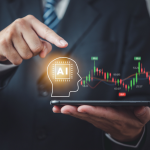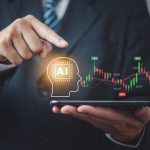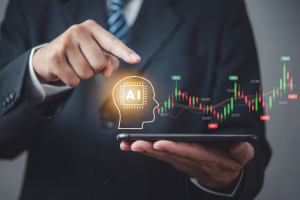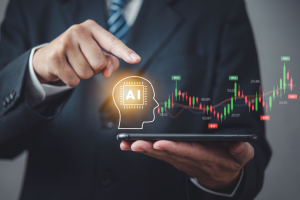
These three disruptor stocks stand at the forefront of innovation in an era marked by technological revolutions. Specifically, their progressive focus on harnessing the power of AI and cutting-edge technology is reshaping the transportation landscape and beyond. From ride-sharing to predictive maintenance and electric vehicles, these companies are rewriting the rules and propelling us into a future where AI-driven solutions are the new normal.
The article dives into their remarkable moves, from the first’s historic profitability milestones to the second’s transformative impact on federal agencies and the third’s record-breaking production figures. It explores how these titans are pushing the boundaries of disruption and revolutionizing entire industries.
Uber (UBER)

The ride-sharing company Uber (NYSE:UBER) is at a pivotal moment in its history, marked by significant milestones. For years, profitability seemed elusive for Uber. Skeptics abounded, with many believing the ride-sharing giant would never turn a profit. However, Uber has defied these doubts. It is done by achieving two pivotal milestones in Q2 2023: its first-ever GAAP operating profit of $326 million and free cash flow exceeding $1 billion.
Regarding disruptions, Uber’s prowess in machine learning and AI sets it apart in optimizing pricing, matching and routing. Uber acknowledges the role of large language models (LLMs) in improving user experiences by predicting appropriate responses.
Uber’s AI capabilities technically extend well beyond LLMs, focusing on deep learning models that enhance pricing and routing efficiency. Uber’s marketplace capabilities and ability to innovate on machine learning models are evident in various key metrics. Such as Uber’s estimated time of arrival outperforms competitors, and it gains category position in eight out of its top ten markets.
On the other hand, Uber’s lead in autonomous vehicles is a strategic move that could revolutionize the transportation industry. The partnership with Waymo signifies Uber’s focus on leveraging cutting-edge technology. Notably, there is still time to determine the exact economics of AV deployment. However, Uber aims to create a routing layer that efficiently assigns demand to human drivers or autonomous vehicles, including Waymo and others.
Finally, Uber’s partnership strategy extends to a portfolio of autonomous partners, including Aurora and Waabi in trucking and various delivery partners. This diversified approach positions Uber to play a significant role in the emerging AV ecosystem.
C3.ai (AI)
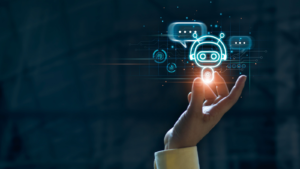
C3.ai (NYSE:AI) has consistently demonstrated financial prowess, impressively meeting or exceeding revenue guidance for 11 consecutive quarters.
To begin with, C3.ai’s partner ecosystem is rapidly expanding, with partnerships that include tech giants such as Alphabet’s (NASDAQ:GOOG, NASDAQ:GOOGL) Google Cloud, Amazon’s (NASDAQ:AMZN) AWS, Microsoft (NASDAQ:MSFT) and Booz Allen Hamilton (NYSE:BAH).
In Q1 fiscal 2024, 60% of agreements were closed through this network, demonstrating solid collaborative relationships. Moreover, the qualified partner opportunity has grown by over 100% in fiscal 2023. This growth indicates the increasing demand for C3.ai’s solutions and the trust established within its partner network.
Additionally, C3.ai is making significant inroads in the federal sector, particularly with the US Department of Defense (DoD). Federal bookings have surged by 39% YoY, reflecting the trust and confidence of government agencies in C3.ai’s solutions. The company actively engages in new and expanded projects with key DoD entities. It includes the Chief Digital and AI Office (CDAO), the US Marine Corps, the US Air Force, the Missile Defense Agency and the Defense Counterintelligence Security Agency.
Technically, these projects focused on improving readiness, predictive maintenance and decision advantage within the DoD. For example, C3.ai’s work with the US Air Force has substantially improved aircraft maintenance procedures, leading to cost savings and increased mission capability. Moreover, C3.ai’s Predictive Analytics and Decision Assistant (PANDA) system may revolutionize predictive maintenance applications across the US Air Force. Looking forward, the system may save $3 billion in maintenance costs.
Overall, the strong presence in the federal sector contributes to revenue growth and positions C3.ai as a trusted partner in critical national security initiatives. Thus, it is solidifying its reputation and opening doors to transformative collaborations.
Tesla (TSLA)
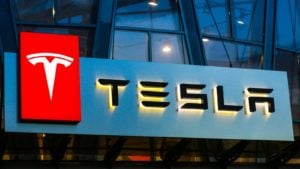
Tesla (NASDAQ:TSLA) achieved record vehicle production and deliveries in Q2 and Q3 2023, despite the planned downtimes for factory upgrades. The impressive performance suggests Tesla’s ability to meet the growing demand for electric vehicles (EVs). Model Y, in particular, became the bestselling vehicle globally in Q1, surpassing popular models like the Toyota (NYSE:TM) Corolla and Volkswagen (OTCMKTS:VWAPY) Golf.
Focusing on autonomy, Tesla believes that it will revolutionize the automotive industry. The company plans to leverage its vast fleet of vehicles to collect training data for neural networks. It is a crucial component of autonomous driving. As a result, Tesla has a significant lead over competitors in terms of the amount of real-world data collected. It is giving Tesla a substantial advantage in developing self-driving technology.
Additionally, Tesla is also working on dedicated robotaxi products. Tesla anticipates these products will have “quasi-infinite demand.” These robotaxis will be manufactured using a revolutionary design and production process, setting new standards for efficiency in vehicle manufacturing. This development could reshape the transportation industry by providing a cost-effective and efficient autonomous ride-sharing service.
Tesla’s progress in AI endeavors is fundamentally driven by its access to talent, unique data and computing resources. Tesla’s Dojo training computer is designed to reduce the cost of neural net training and is optimized for video training, a critical component of autonomous driving. Favorably, Dojo’s capabilities may reach beyond autonomous driving. Notably, Dojo’s efficient neural net training capabilities could have applications in healthcare, finance and more, where AI and machine learning are used to analyze vast datasets and make predictions or decisions.
Finally, Tesla aims to achieve in-house neural net training capabilities of 100 exaflops by the end of the following year, further strengthening its AI capabilities.
On the date of publication, Yiannis Zourmpanos did not hold (either directly or indirectly) any positions in the securities mentioned in this article. The opinions expressed in this article are those of the writer, subject to the InvestorPlace.com Publishing Guidelines.

